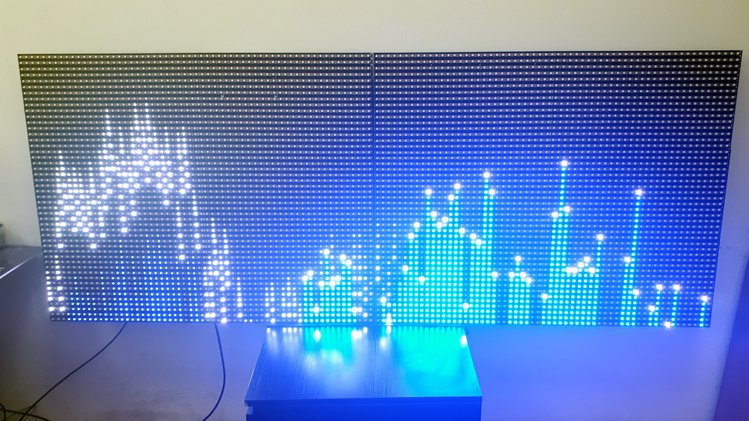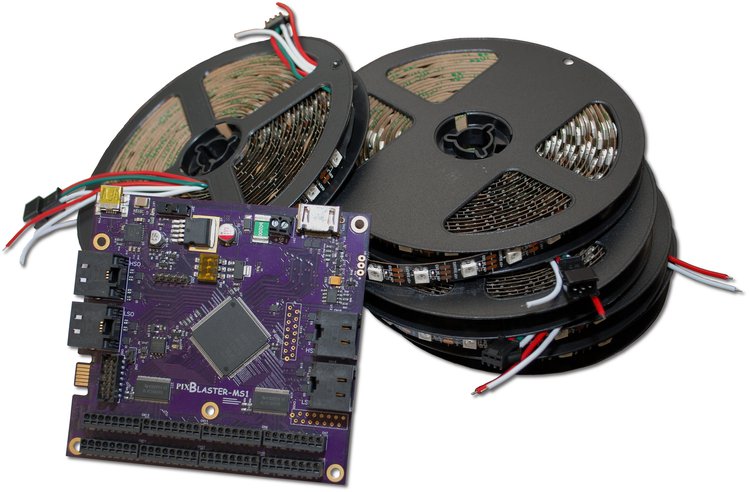
Startup Touts Gear And Plan For End-Users To Make Low Rent Direct View LED Displays
October 10, 2019 by Dave Haynes
Heavy traffic, every day, for posts on Raspberry Pi options and free digital signage software tell me there is a substantial constituency out there that does not want to pay market prices for mainstream digital signage technology.
I’ve seen it with player hardware (Android sticks and set-top boxes) and play-out software, but I did not expect to see it for LED displays – particularly since there are 100s of low cost direct view LED options that are just an Alibaba search away.

But … a start-up called Pixblasters, led by a couple of Croatian guys, is crowdsourcing the money to start a project that would see users buy a controller device for just over $200 that would drive content to strips of LEDs that come on reels and could be glued down on backplates to make modules. Put a few modules together and you have a low rent LED display!
The elevator pitch:
Due to their high cost and complexity, huge, shiny, beautiful video displays with thousands of LEDs have always been out of reach of enthusiasts and small business owners. Pixblasters MS1 changes all of that.
Pixblasters MS1 enables DIY enthusiasts and signage professionals, even those with minimal technical skills, to turn a bunch of addressable RGB LED strips into immense video LED displays. This FPGA-based LED controller enables new levels of professional-grade digital signage that cannot be attained by standard LED modules. The LED strips can be curved and glued to different surfaces to form giant yet economically viable video installations that can span entire buildings.
The proponents say the project was driven by curiosity and a desire to reduce costs …
The idea for this project was accidentally born in a random conversation about an independently shared DIY dream. Twenty years ago, both of us were dreaming about building a large video LED screen. At that time it was a difficult undertaking and out of reach to the vast majority of DIY makers.
While red and green LEDs were relatively reasonably priced, the blue LEDs were extremely expensive and locally available for roughly $6/pc. This meant that the LED material bill alone for a relatively small 100 x 50 (H x V) display was around $40,000! That doesn’t even include the LED driver chips, power supply, video engine, etc.
As LED technology has advanced, it has been accepted and incorporated into a wide range of applications. The rise of low-cost and reliable single-board computers like the Raspberry Pi combined with our advanced knowledge of FPGA technologies to create this project.
Today we are able to produce a 100 x 50 LED screen that costs more than 100 times less!
That would mean less than $400, though depending on pitch, that might be a teeny screen.
Nonetheless, interesting … I’m not anywhere sufficiently technical to say whether this is a great idea or a disaster in waiting, but if I had my consultant hat on, I’d be strongly advising a client to spend the money on real product from a real company with real support.
But sometimes, there’s minimal budget, or someone in an organization who insists there’s no need to pay retail when there are DIY solutions out there.
Here’s the crowdsourcing pitch:



This is a pretty interesting project for hobbyists/makers, but I’m not sure where it lands in the market. Most small businesses are not going to have the skillset on hand to pull this off which I’d believe is the “ideal” client. Maybe a system integrator could start to productize it – but as you point out, how responsive is support going to be from 2 guys in a single location?
If they can pull off finer pixel/higher resolution, I’d seriously consider picking up a kit for building an ambient wall at home. A *LOT* cheaper than doing it with Hue and much more flexible.